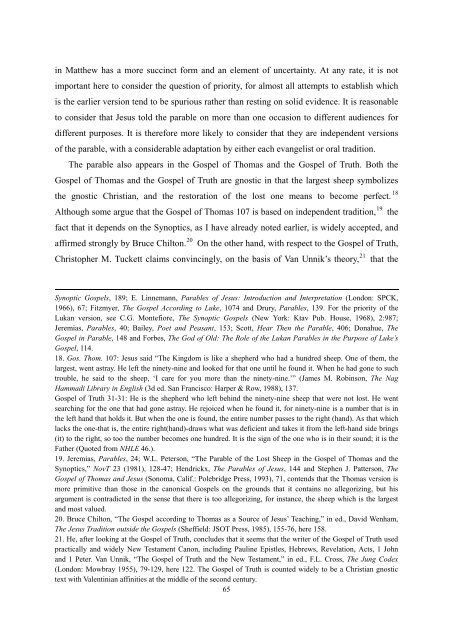the role of the lukan parables in terms of the purpose of luke's gospel
the role of the lukan parables in terms of the purpose of luke's gospel
the role of the lukan parables in terms of the purpose of luke's gospel
Create successful ePaper yourself
Turn your PDF publications into a flip-book with our unique Google optimized e-Paper software.
<strong>in</strong> Mat<strong>the</strong>w has a more succ<strong>in</strong>ct form and an element <strong>of</strong> uncerta<strong>in</strong>ty. At any rate, it is not<br />
important here to consider <strong>the</strong> question <strong>of</strong> priority, for almost all attempts to establish which<br />
is <strong>the</strong> earlier version tend to be spurious ra<strong>the</strong>r than rest<strong>in</strong>g on solid evidence. It is reasonable<br />
to consider that Jesus told <strong>the</strong> parable on more than one occasion to different audiences for<br />
different <strong>purpose</strong>s. It is <strong>the</strong>refore more likely to consider that <strong>the</strong>y are <strong>in</strong>dependent versions<br />
<strong>of</strong> <strong>the</strong> parable, with a considerable adaptation by ei<strong>the</strong>r each evangelist or oral tradition.<br />
The parable also appears <strong>in</strong> <strong>the</strong> Gospel <strong>of</strong> Thomas and <strong>the</strong> Gospel <strong>of</strong> Truth. Both <strong>the</strong><br />
Gospel <strong>of</strong> Thomas and <strong>the</strong> Gospel <strong>of</strong> Truth are gnostic <strong>in</strong> that <strong>the</strong> largest sheep symbolizes<br />
<strong>the</strong> gnostic Christian, and <strong>the</strong> restoration <strong>of</strong> <strong>the</strong> lost one means to become perfect. 18<br />
Although some argue that <strong>the</strong> Gospel <strong>of</strong> Thomas 107 is based on <strong>in</strong>dependent tradition, 19 <strong>the</strong><br />
fact that it depends on <strong>the</strong> Synoptics, as I have already noted earlier, is widely accepted, and<br />
affirmed strongly by Bruce Chilton. 20 On <strong>the</strong> o<strong>the</strong>r hand, with respect to <strong>the</strong> Gospel <strong>of</strong> Truth,<br />
Christopher M. Tuckett claims conv<strong>in</strong>c<strong>in</strong>gly, on <strong>the</strong> basis <strong>of</strong> Van Unnik’s <strong>the</strong>ory, 21<br />
that <strong>the</strong><br />
Synoptic Gospels, 189; E. L<strong>in</strong>nemann, Parables <strong>of</strong> Jesus: Introduction and Interpretation (London: SPCK,<br />
1966), 67; Fitzmyer, The Gospel Accord<strong>in</strong>g to Luke, 1074 and Drury, Parables, 139. For <strong>the</strong> priority <strong>of</strong> <strong>the</strong><br />
Lukan version, see C.G. Montefiore, The Synoptic Gospels (New York: Ktav Pub. House, 1968), 2:987;<br />
Jeremias, Parables, 40; Bailey, Poet and Peasant, 153; Scott, Hear Then <strong>the</strong> Parable, 406; Donahue, The<br />
Gospel <strong>in</strong> Parable, 148 and Forbes, The God <strong>of</strong> Old: The Role <strong>of</strong> <strong>the</strong> Lukan Parables <strong>in</strong> <strong>the</strong> Purpose <strong>of</strong> Luke’s<br />
Gospel, 114.<br />
18. Gos. Thom. 107: Jesus said “The K<strong>in</strong>gdom is like a shepherd who had a hundred sheep. One <strong>of</strong> <strong>the</strong>m, <strong>the</strong><br />
largest, went astray. He left <strong>the</strong> n<strong>in</strong>ety-n<strong>in</strong>e and looked for that one until he found it. When he had gone to such<br />
trouble, he said to <strong>the</strong> sheep, ‘I care for you more than <strong>the</strong> n<strong>in</strong>ety-n<strong>in</strong>e.’” (James M. Rob<strong>in</strong>son, The Nag<br />
Hammadi Library <strong>in</strong> English (3d ed. San Francisco: Harper & Row, 1988), 137.<br />
Gospel <strong>of</strong> Truth 31-31: He is <strong>the</strong> shepherd who left beh<strong>in</strong>d <strong>the</strong> n<strong>in</strong>ety-n<strong>in</strong>e sheep that were not lost. He went<br />
search<strong>in</strong>g for <strong>the</strong> one that had gone astray. He rejoiced when he found it, for n<strong>in</strong>ety-n<strong>in</strong>e is a number that is <strong>in</strong><br />
<strong>the</strong> left hand that holds it. But when <strong>the</strong> one is found, <strong>the</strong> entire number passes to <strong>the</strong> right (hand). As that which<br />
lacks <strong>the</strong> one-that is, <strong>the</strong> entire right(hand)-draws what was deficient and takes it from <strong>the</strong> left-hand side br<strong>in</strong>gs<br />
(it) to <strong>the</strong> right, so too <strong>the</strong> number becomes one hundred. It is <strong>the</strong> sign <strong>of</strong> <strong>the</strong> one who is <strong>in</strong> <strong>the</strong>ir sound; it is <strong>the</strong><br />
Fa<strong>the</strong>r (Quoted from NHLE 46.).<br />
19. Jeremias, Parables, 24; W.L. Peterson, “The Parable <strong>of</strong> <strong>the</strong> Lost Sheep <strong>in</strong> <strong>the</strong> Gospel <strong>of</strong> Thomas and <strong>the</strong><br />
Synoptics,” NovT 23 (1981), 128-47; Hendrickx, The Parables <strong>of</strong> Jesus, 144 and Stephen J. Patterson, The<br />
Gospel <strong>of</strong> Thomas and Jesus (Sonoma, Calif.: Polebridge Press, 1993), 71, contends that <strong>the</strong> Thomas version is<br />
more primitive than those <strong>in</strong> <strong>the</strong> canonical Gospels on <strong>the</strong> grounds that it conta<strong>in</strong>s no allegoriz<strong>in</strong>g, but his<br />
argument is contradicted <strong>in</strong> <strong>the</strong> sense that <strong>the</strong>re is too allegoriz<strong>in</strong>g, for <strong>in</strong>stance, <strong>the</strong> sheep which is <strong>the</strong> largest<br />
and most valued.<br />
20. Bruce Chilton, “The Gospel accord<strong>in</strong>g to Thomas as a Source <strong>of</strong> Jesus’ Teach<strong>in</strong>g,” <strong>in</strong> ed., David Wenham,<br />
The Jesus Tradition outside <strong>the</strong> Gospels (Sheffield: JSOT Press, 1985), 155-76, here 158.<br />
21. He, after look<strong>in</strong>g at <strong>the</strong> Gospel <strong>of</strong> Truth, concludes that it seems that <strong>the</strong> writer <strong>of</strong> <strong>the</strong> Gospel <strong>of</strong> Truth used<br />
practically and widely New Testament Canon, <strong>in</strong>clud<strong>in</strong>g Paul<strong>in</strong>e Epistles, Hebrews, Revelation, Acts, 1 John<br />
and 1 Peter. Van Unnik, “The Gospel <strong>of</strong> Truth and <strong>the</strong> New Testament,” <strong>in</strong> ed., F.L. Cross, The Jung Codex<br />
(London: Mowbray 1955), 79-129, here 122. The Gospel <strong>of</strong> Truth is counted widely to be a Christian gnostic<br />
text with Valent<strong>in</strong>ian aff<strong>in</strong>ities at <strong>the</strong> middle <strong>of</strong> <strong>the</strong> second century.<br />
65
















